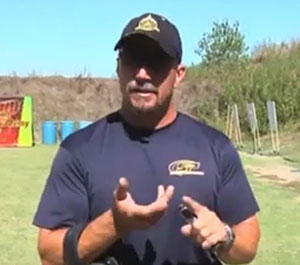 So I want to take just a couple minutes and talk to you about what kind of pressure I'm applying on the gun. Because remember, during the firing cycle, we're managing three things, the sites, the trigger and recoil. So to manage recoil, I need to know where I need to put pressure on the gun to be most effective. So lemme demonstrate a couple of things here. Got an unloaded firearm. So when I'm actually gripping and shooting the gun, I pay attention to applying pressure where I think it's most important. And if I go ahead and apply lots and lots of pressure on the side of the grip panels, that in essence is only controlling the recoil through friction of, for example, between the grip tape here itself and the palms of my hands. However, if I can find a way to apply pressure on the back of the gun, now I have leverage against the gun and that pressure kind of builds a wall back there, which causes the front side to snap down and return.
So I want to take just a couple minutes and talk to you about what kind of pressure I'm applying on the gun. Because remember, during the firing cycle, we're managing three things, the sites, the trigger and recoil. So to manage recoil, I need to know where I need to put pressure on the gun to be most effective. So lemme demonstrate a couple of things here. Got an unloaded firearm. So when I'm actually gripping and shooting the gun, I pay attention to applying pressure where I think it's most important. And if I go ahead and apply lots and lots of pressure on the side of the grip panels, that in essence is only controlling the recoil through friction of, for example, between the grip tape here itself and the palms of my hands. However, if I can find a way to apply pressure on the back of the gun, now I have leverage against the gun and that pressure kind of builds a wall back there, which causes the front side to snap down and return.
I'll demo this live fire here in just a second. So imagine my strong hand being as high as I can possibly get it on the grip or on the back strap of the handgun. And I can feel a lot of pressure in the palm of my hand. The second part of this, the high performance grip, is because the thumb is flagged. That allows me to really get that left hand in there. And in essence, if I were to show you my left hand grip, that's what it looks like on the gun. Now granted, my right hand would normally be on it, and if you notice, the palms of my hand or the palm of my left hand is actually squeezing on that rear left quarter panel of the handgun itself. Here in a second I'm going to show you how much recoil control that actually offers me without the second hand on the gun.
So what I've done here is I've got one hand high in the gun, the second hand high in the gun because of that thumb allows it. Now the strong hand thumb lays down and when I extend the gun out there, I'm actually going to increase the tension in my chest muscles and my deltoid. So I'm actually pressing on the gun from behind it, trying to increase pressure on the back of the gun. And the more pressure I have on the back of the gun, the more of a snapping effect I have during recoil. Let me show you what that looks like. Live fire. Okay, first, a quick demonstration. I wanted to show you what my left hand actually does for the grip of the handgun. So when my left hand is gripping the handgun, it's going to be on my top of my right hand about like that.
So what I'm going to do is I'm going to fire a shot, and this is my left hand only. This hand is simply holding down the grip safety and firing shot. I'm applying no pressure with my right hand. Watch how much control the handgun I have on my left hand only see how the gun barely moves. That's just with my left hand. So now when I build my full final firing grip, now I've got the right hand involved. I'm driving my left hand palm in, and my right palm in, and I'm increasing the pressure on my chest and my shoulder muscles and watch how the gun snaps back to return. So when I fire a shot, the gun literally snaps back. And the only thing that limits my shooting speed is that the speed with which I can pull the trigger. Conversely, if I were to shoot with the loose grip, watch how the gun recoils returns. Now with a loose grip and loose tendons, it's flipping way up and it's not returning. So
Lastly, remember that the grip high performance grip has to be leveraged by applying the right pressure to the right areas, locking those tendons out, and then using the big dumb muscles in your upper body, as Mike Hughes would say, to control the rest of that recoil. And in summary, those are the things that are going to help you learn how to manage recoil to your highest potential.
YouTube Video Link: https://www.youtube.com/watch?v=HgtAFLsXnVs
Credit: Mike Seeklander
